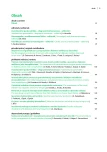What are biosimilars and what do they bring to us?
Authors:
Jiří Slíva 1,2
Authors‘ workplace:
Farmakologický ústav 2. LF UK Praha, přednosta doc. MUDr. Martin Votava, Ph. D.
1; Ústav farmakologie 3. LF UK Praha, přednosta prof. MUDr. Jan Bultas, CSc.
2
Published in:
Vnitř Lék 2015; 61(2): 143-145
Category:
Review
Overview
Biosimilar medicines are a new category of medicinal products that substantially differ from generic preparations through the necessary submission of conclusive evidence of their therapeutic efficacy and therefore it is not sufficient to merely state their biological equivalence. Apart from the proven efficacy, also their safety is evaluated of course, with an emphasis on immunogenicity regarding biological nature of these substances. As a result, requirements for registration are much stricter. With regard to the current boom of the preparations labelled in a simplified way as biological or specifically targeted drugs, we can certainly expect a growing number of newly registered medicinal products in this category in the near future. Last year, a biosimilar insulin analogue of glargine was approved for administration at the level of the European Medicines Agency (EMA) in accordance with the aforementioned procedures; its efficacy and safety profile have been found within the registration studies practically identical, or non-inferior, to the original insulin analogue.
Key words:
biosimilars – glargine – insulin – insulin analogues – registration
Sources
1. Minocha M, Gobburu J. Drug Development and Potential Regulatory Paths for Insulin Biosimilars. J Diabetes Sci Technol 2014; 8(1): 14–19.
2. US Food and Drug Administration. Guidance for industry: Scientific considerations in demonstrating biosimilarity to a reference product 2012. Dostupné z WWW: <http://www.fda.gov/downloads/drugs/guidancecomplianceregulatoryinformation/guidances/ucm291128.pdf>.
3. European Medicines Agency. Guideline on similar biological medicinal products containing biotechnology-derived proteins as active substance: non-clinical and clinical issues. Dostupné z WWW: <http://www.ema.europa.eu/docs/en_GB/document_library/Scientific_guideline/2013/06/WC500144124.pdf>.
4. Sharma B. Immunogenicity of therapeutic proteins. Part 3: Impact of manufacturing changes. Biotechnol Adv 2007; 25(3): 325–331.
5. Kuhlmann M, Marre M. Lessons learned from biosimilar epoetins and insulins. British Journal of Diabetes & Vascular Disease 2010; 10(2): 90–97.
6. Informace dostupné z WWW: European Medicines Agency (2013). European public assessment reports: Biosimilars. <http://www.ema.europa.eu/ema/index.jsp?curl=pages%2Fmedicines%2Flanding%2Fepar_search.jsp&mid=WC0b01ac058001d125&searchTab=searchByAuthType&alreadyLoaded=true&isNewQuery=true&status=Authorised&status=Withdrawn&status=Suspended&status=Refused&keyword=Enter+keywords&searchType=name&taxonomyPath=&treeNumber=&searchGenericType=biosimilars&genericsKeywordSearch=Submit>. Accessed Nov 2013.
7. Rotenstein LS et al. Opportunities and Challenges for Biosimilars. What’s on the Horizon in the Global Insulin Market? Clin Diabetes 2012; 30(4): 138–150.
Labels
Diabetology Endocrinology Internal medicineArticle was published in
Internal Medicine

2015 Issue 2
Most read in this issue
- Spontaneous bacterial peritonitis
- The examination of the small intestine by magnetic resonance imaging
- Empagliflozin – the new representative of SGLT2 transporter inhibitors for the treatment of patients with diabetes 2 type
- The importance of transcutaneous oxygen tension monitoring in diabetic patient with complications
